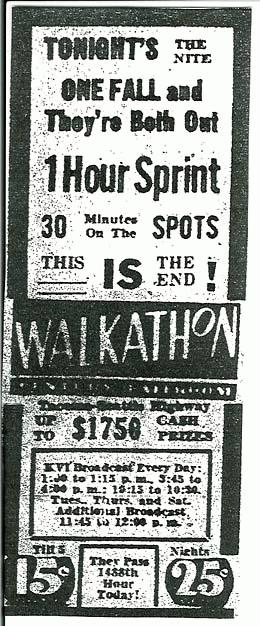On August 30, 1936, a dance marathon/walkathon closes in Fife, a community just north of Tacoma, after 1,600 hours (66 days or more than two months). The event is popular with citizens of nearby Seattle and Tacoma, both of which have city ordinances banning dance endurance contests. Dance marathons are human endurance contests in which couples dance almost non-stop for hundreds of hours (as long as a month or two), competing for prize money.
Hotly Contested
The contest took place in the Century Ballroom on the Tacoma-Seattle Highway, the same location in which a dance marathon had drawn full houses the year before.
The 1936 Fife show was mounted by promoter Rookie Lewis. Contestants, a mixture of professionals and hopeful amateurs, dance to the music of "Goodwin Goldie’s Walkathonians -- So Hot They’ll Scorch the Airways!" (Tacoma News Tribune, June 26, 1936). Radio KVI broadcast from the contest three times daily.
Dance marathons arose during the 1920s and were popular during the 1930s as inexpensive, enthralling, emotionally charged entertainment. Also called walkathons, the events were human endurance marathons in which contestants danced and shuffled around the clock with 15 minutes rest allotted every hour. Meals were served to the still-standing contestants 12 times a day. While true endurance was certainly required, dance marathons were usually staged to some extent and it was a rare contest in which a first-time hopeful finished a winner.
During the evening audiences watched vaudeville-type entertainment. As the marathon wore on contestants were subjected to increasingly brutal elimination events.
The 1936 Fife marathon began at 9:30 pm on June 25, 1936, when Pierce County Sheriff John C. Bjorklund fired the starting gun. Law enforcement officers were usually not fond of dance marathons, because they often provoked storms of protest from church and community groups, as well as attracting a lawless element to the towns in which they were held. Sheriff Bjorklund, however, was tolerant of the events.
Public Sleeping
Within two weeks Rookie Lewis was offering audiences "Cot Night," in which the contestants took their brief rest periods and received care from trainers on cots pulled onstage within full view of the audience.
Elimination events such as sprint races, combined with the summer heat, reduced the contestant base at a steady clip. "Stumbling, Staggering, On They Go! Who will be the next to be carried off the floor … They pass the 623rd hour today!" read a display advertisement in The Tacoma Times (June 21, 1936).
On July 24, audiences saw a dance marathon staple, the public wedding. Russell Campbell of Sumner and Jennie Van Ness of Puyallup were married "with the entire wedding party dressed entirely in cellophane" (The Tacoma Times).
Weddings and Wrestling
On July 31, Lewis outdid himself in terms of spectacle by staging an "Indian Wedding" for the evening’s special attraction. The Tacoma Times promised, "The wedding will unite So-To-Le-O, bride to be, and Quan-Le-Ales, groom, and will be directed by Chief White Eagle … Elaborate preparations have been made by the Walkathon management to bring out all of the tribal splendor, with beautiful settings and scenic effects" (July 31, 1936).
Lewis also staged "Athletic Carnivals" and wrestling matches as evening entertainment during the Fife marathon. In no hurry to end the event while crowds continued attending, Lewis subjected the contestants to short (only 10 minutes) running sprints during most of the show. Not until the contest had passed the 1,200-hour mark did Lewis institute the longer sprints and treadmill periods, which resulted in contestants falling or collapsing and thus being disqualified.
"So loyal are a majority of the fans attending this thrilling event," reported The Tacoma Times on August 17, 1936, "that they single out their favorite contestant from the start and as the contest progresses become so enthusiastic that they bring almost every known type of noisemaker to keep them from falling asleep and being disqualified."
At 9 p.m. on August 29, the two couples remaining began a "positive elimination sprint with no time limit, the rules stating that they will sprint until the winner is decided" (The Tacoma News-Tribune). Professional contestants Scottie Reed and Ida Reeves, veterans of many marathons, won the $1,000 first place prize. Fellow professionals Charley Loeb and Chad Alviso won the $500 second place award.

